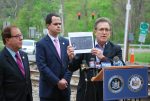Lawmakers Press State to Force DOT Rail Crossings Study

Two state legislators renewed their call last Friday for the state Senate to require the Department of Transportation (DOT) to study grade crossings throughout New York in hopes of avoiding future tragedies.
State Sen. David Carlucci (D-Clarkstown) and Assemblyman Thomas Abinanti (D-Pleasantville) were joined by Edgemont resident Alan Brody, whose wife Ellen was killed when her SUV was struck by a train at the Commerce Street crossing in Valhalla on Feb. 3, 2015.
“We’ve had so many different types of situations that it’s time to bring in some experts to take a look at the problem,” Abinanti said at the same crossing where last year’s accident occurred.
Five Metro-North passengers were also killed in the incident, which drew national attention. Brody has since filed a wrongful death suit in state Supreme Court against the state, MTA, Metro-North and the Town of Mount Pleasant claiming safety hazards had not been properly addressed.
On Apr. 27 a car was struck at the Green Lane grade crossing in Bedford just after the vehicle’s occupants managed to escape.
“The public has to stay on top of this, or nothing will change” Brody said.
Carlucci’s and Abinanti’s bill instructs the DOT to conduct a study of the more than 5,300 railroad crossings statewide to assess where safety improvements could be made. They are calling for the cooperation of the MTA and commercial railroad companies.
Many of the current railroad crossings were designed for less populated areas and have antiquated safety features that are inadequate for modern cars and higher traffic volumes, Abinanti explained.
The bill was already passed in the Assembly and now awaits a vote in the Senate. Carlucci said he hopes it will soon be approved.
“We no longer live in rural America,” Abinanti said. “You see here at noon a steady stream of traffic going across. If you come back here at 5 p.m. you’ll see bumper-to-bumper traffic. You have a problem on the Bronx River Parkway where the cars back up onto the railroad tracks.”
“We need to know which rail crossings are the most deadly, which rail crossings are the most dangerous, which ones have to be completely eliminated and which just need minor signage or maybe some new technology with positive rail controls,” Carlucci said. “We need to have a complete inventory so we can spend our resources and the taxpayer’s money in the most effective and efficient ways to save people’s lives.”
The Federal Railroad Administration recently informed the states that funding is available for safety-related rail crossing improvements, Carlucci said. He said creating inventory of what needed to be done in New York was the first step in obtaining funds for various projects.
However, Carlucci said complaints about crossings from the public or elected officials, no matter how legitimate they may seem, carry little weight with the state. A DOT study would have much more influence, he said.
The two lawmakers said they believed the DOT could fund such a study. It could also get additional funding from the governor’s office.
Brody said a small sign indicating a sharp turn at the Commerce Street crossing is an example of a needed improvement.
“The DOT gave the MTA $160,000 to put a warning sign over there, but they never did it,” Brody said. “Instead, they took a small amount of money and changed the light bulbs so they’ll never have to change them again. They’re LED, but nobody asked them for LED, they asked for a warning sign.”
Brody said he also didn’t understand why the speed limit on the Taconic State Parkway, which runs parallel to the rail tracks, was 40 miles per hour but the railroad speed limit is 60 miles per hour and runs through a well-traveled area. He said easy solutions using modern technology could be implemented if the MTA wanted to do so.
“This is like a neighbor who has a rickety staircase, and when you ask them why they don’t fix it (because) I almost killed myself, they say ‘Why should I, I’m used to it,’” Brody said.
Last week New Castle Supervisor Rob Greenstein said state Sen. Terrence Murphy (R-Yorktown) is sponsoring a bill requiring the MTA and DOT to conduct joint inspections of traffic signals at interconnected grade crossings every two years. New Castle officials have voiced concern over the safety of the Roaring Brook Road crossing in Chappaqua.
“Anything we can do to increase railroad safety crossing is a very good thing,” Greenstein said. “The cooperation with the federal government is also very encouraging. That cooperation will certainly be needed as we work to eliminate on-grade railroad (crossings).”
Martin Wilbur contributed to this article.

Examiner Media – Keeping you informed with professionally-reported local news, features, and sports coverage.
